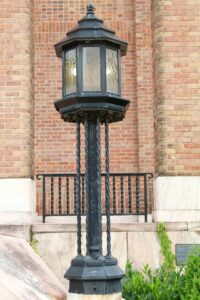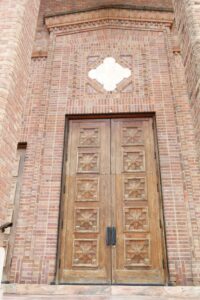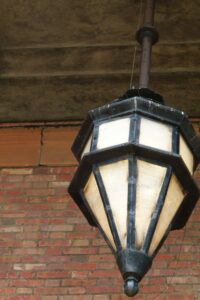Douglas Dobell Ellington: Asheville’s Boomtown Architect
Asheville’s economic and building boom of the 1920s created a rarified atmosphere unique within Western North Carolina. Douglas Ellington is known as the architect who changed Asheville into an Art Deco showplace. With his ability to combine architectural styles he produced a series of one of a kind buildings—buildings which changed the face of Asheville—the City Building, Asheville High School, First Baptist Church and S&W Cafeteria. Douglas Ellington: Asheville’s Boomtown Architect presents a look at his iconic Asheville creations along with other buildings he completed throughout his career in other cities.
DOUGLAS ELLINGTON
(1886 – 1960)
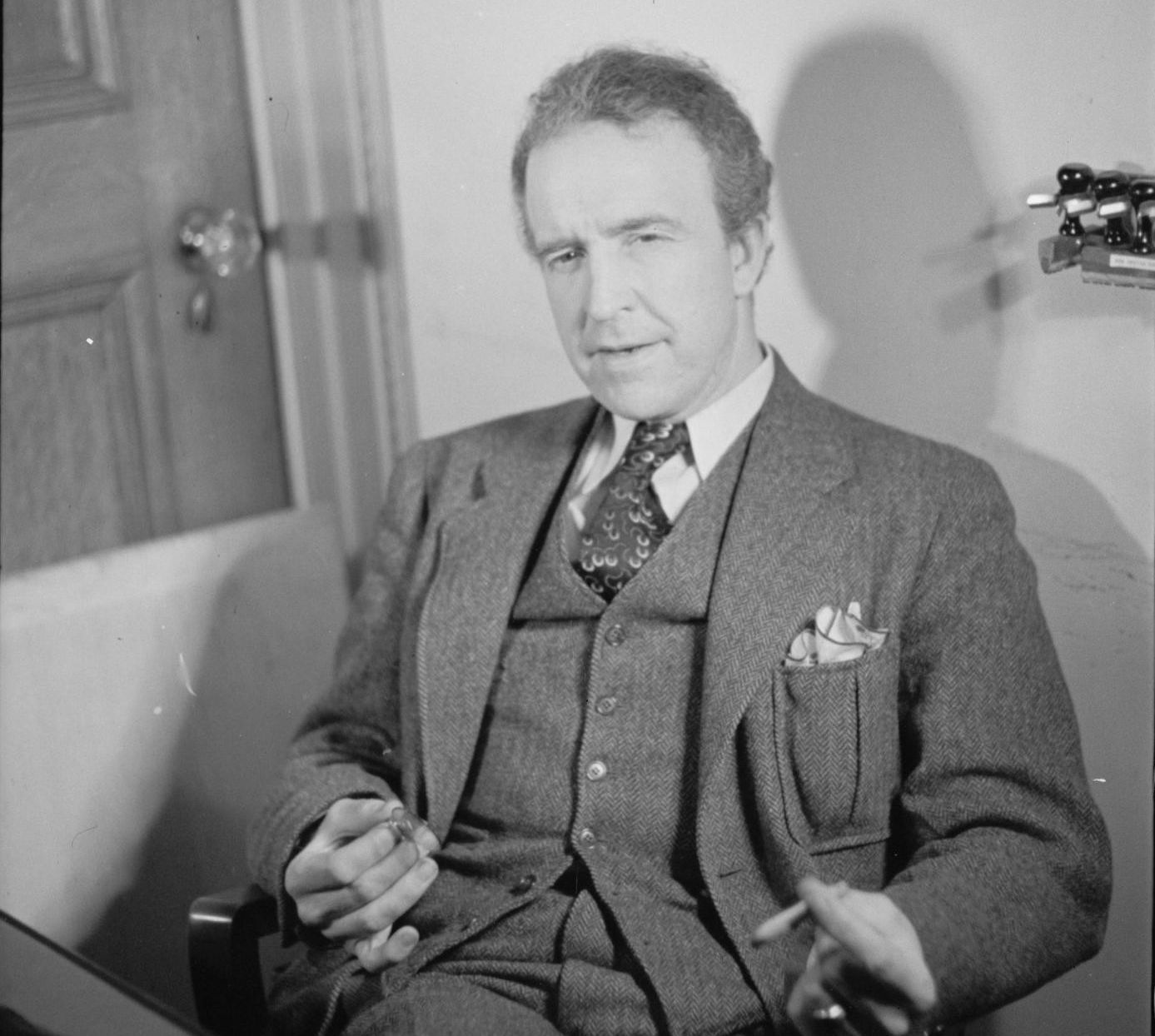
Douglas D. Ellington was descended from John Ellington of England who arrived at the Royal Colony of Virginia in 1717. His son, Jesse, who fought in the War of 1812, married Martha Tucker of Johnston County, North Carolina. Six generations later Douglas D. Ellington was born on June 3, 1886 in Clayton, North Carolina, the oldest son of Jesse Thomas Ellington and his second wife, Sallie Williamson. A younger brother, Kenneth, became an attorney. Another brother, Eric Lamar, a first lieutenant in the Third Calvary attached to the 1st Army Aero Squadron, was killed during a training flight in San Diego, California, on November 24, 1913. Ellington Air Field in Houston, Texas, is named in his honor.
Douglas Ellington’s creative abilities and artistic bent revealed themselves at an early age. After finishing high school and an undergraduate degree from Randolph-Macon College, he studied architecture at Drexel Institute and at the University of Pennsylvania where he earned the degree of Bachelor of Science in Architecture with the class of 1912. While a student he was employed by the architectural firms of George B. Post & Sons, New York, and E. B. Lee of Pittsburgh.
BEGINNINGS
(1911 – 1918)
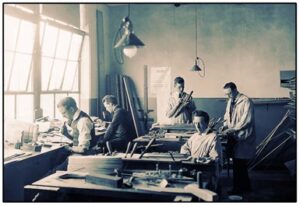
In 1911 he was awarded the Paris Prize granted by the Beaux Arts Society of New York. The award included the opportunity for study at the Ecole des Beaux Arts in Paris. While a student in the atelier of Victor Laloux he won the Prix de Rougevin for a measured drawing of the Church of Saint Trophime at Arles, France – the first American to do so.
Like so many artists, writers, medical students, and musicians of his and previous generations, Ellington planned on remaining in Europe for several more years. Unfortunately, the advent of the World War forced a change in plans and he returned to the United States in 1914 and enlisted as a chief petty officer in the United States Navy. He put his artistic talents to use designing camouflage for war ships.
THE PITTSBURGH YEARS
(1918 – 1925)

When World War II ended in 1918, Douglas Ellington accepted teaching positions at the University of Pennsylvania and later at the Carnegie Institute in Pittsburgh. Both schools were strongholds of the Beaux Arts style. In 1925 he, with his brother Kenneth acting as office manager, set up an architectural firm in Pittsburgh in the Wabash Building. Kenneth Ellington’s influence on his brother’s career cannot be overstated. He negotiated commissions, administered finances, and kept his brother in tailored suits.
During the next five years Douglas Ellington designed a number of structures in the greater Pittsburgh area including several restaurants and Emory Methodist Church. The church burned in the early 1970s and was replaced by a new building. Both of Ellington’s restaurants were demolished when the theaters, with which they were associated, closed. Remaining today are the bridge abutments he designed for the 6th, 7th, and 9th Street bridges across the Allegheny River.
In 1925, with the commission of The First Baptist Church of Asheville, Ellington closed his Pittsburgh office and he and his brother settled in Asheville. His first office was at 16 ½ Wall Street. A year later the office moved across the street to Suite 506 in the Flatiron Building.
ASHEVILLE, NORTH CAROLINA
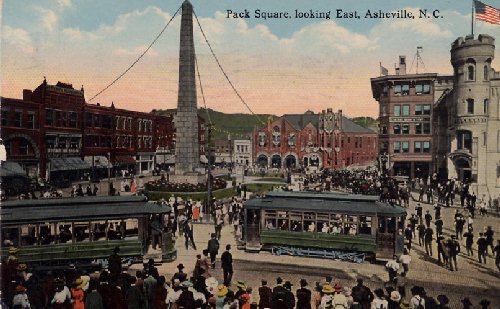
Despite its designation in 1797 as the county seat of the newly formed Buncombe County, 18th century Asheville was little more than a crossroads.
Fifty years later, with a population of 1,400, the city was beginning to acquire a reputation as a vacation destination. Nevertheless, with no railroad or telegraph connection to the rest of the country, Asheville remained relatively isolated. With the completion of the Western North Carolina Railroad in 1880 everything changed. Within ten years the city’s population had climbed to 14,694. Electric street cars plied the main thoroughfares and magnificent hotels, upscale retail stores, fine restaurants, theaters, and an opera house sprung up within the city.
Growth continued unabated into the 20th century. But, it was not until the 1920s that Asheville became a true boomtown. Asheville’s citizens were confident that there was simply no limit to the future of their city. By 1925 the population was over 30,000 and climbing at an astounding rate.
It was within this whirlwind of optimism and building activity that 43-year-old Douglas Ellington arrived in 1925.
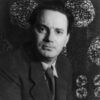
The real estate men were everywhere. Their motors and busses roared through the streets of the town and out into the country, carrying crowds of prospective clients. One could see them on the porches of houses unfolding blueprints and prospectuses as they shouted enticements and promises of sudden wealth into the ears of deaf old women. Everyone was fair game for them – the lame, the halt, and the blind, Civil War veterans or their decrepit pensioned widows, as well as high school boys and girls, Negro truck drivers, soda jerkers, elevator boys, and bootblacks.
Everyone bought real estate; and everyone was “a real estate man” either in name or practice. The barbers, the lawyers, the grocers, the butchers, the builders, the clothiers – all were engaged now in this single interest and obsession. And there seemed to be only one rule, universal and infallible – to buy, always buy, to pay whatever price was asked, and to sell again within two days at any price one chose to fix. It was fantastic.
Along all the streets in town the ownership of the land was constantly changing; and when the supply of streets was exhausted, new streets were feverishly created in the surrounding wilderness; and even before these streets were paved or a house had been built upon them, the land was being sold, and then resold, by the acre, by the lot, by the foot, for hundreds of thousands of dollars.
– Thomas Wolfe, You Can’t Go Home Again
ASHEVILLE’S FIRST BUILDING BOOM
(1890s – 1910s)
When Ellington arrived in Asheville, the wide range of architectural styles which comprised the city’s building boom still dominated Asheville.
- Allen L. Melton’s Drhumor Building of 1895 and Asheville City Hall of 1892 were fully developed examples of Romanesque Revival style.
- Richard Sharp Smith’s 1909 Italian Renaissance Palazzo style Legal Building graced Pack Square.
- The St. Lawrence Catholic Church, designed by Raphael Guastavino, was a magnificent statement in the Spanish Baroque style.
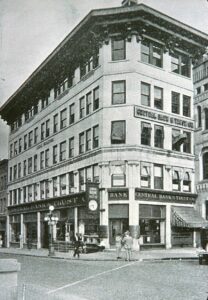
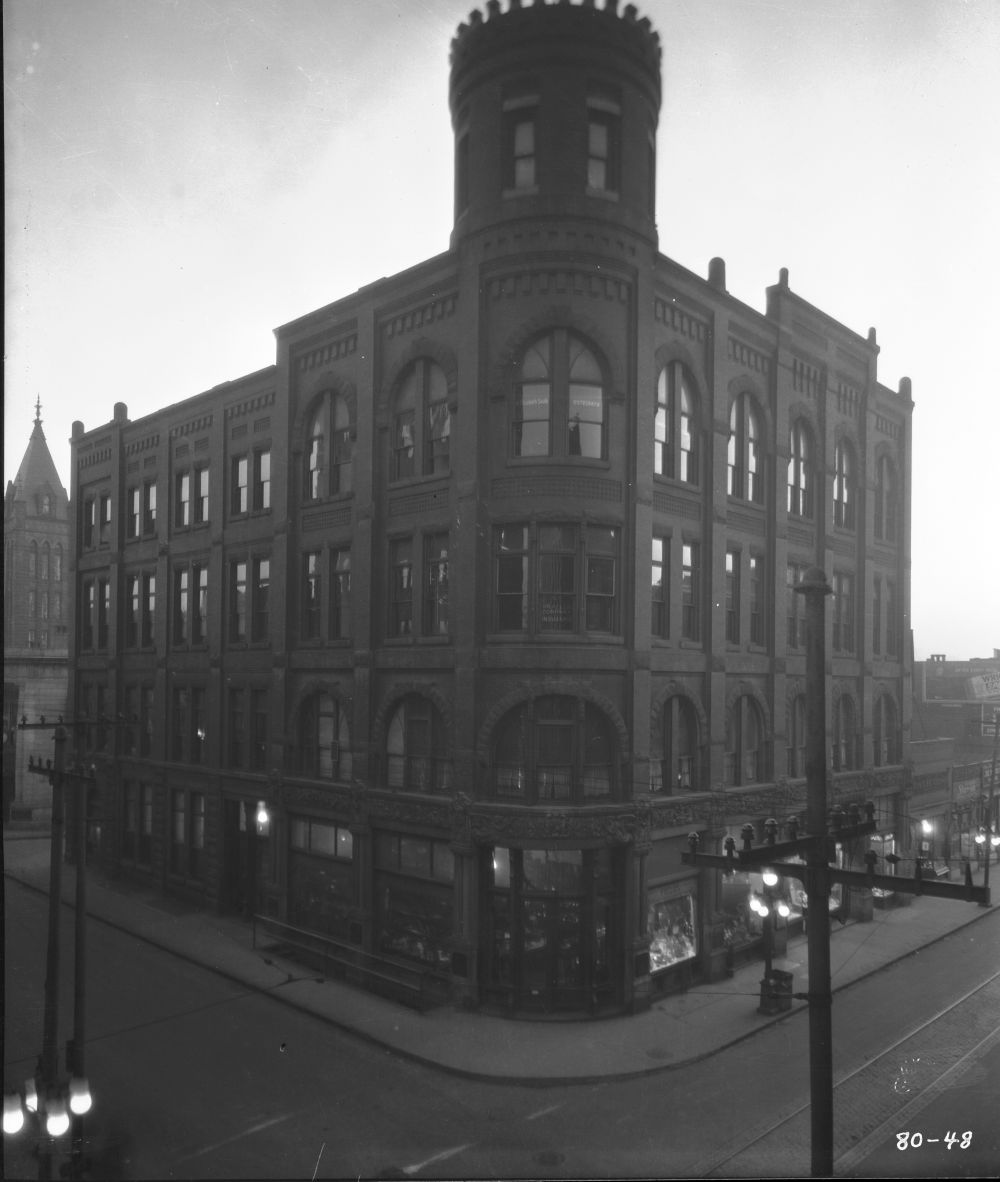
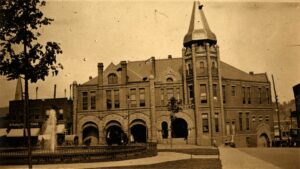
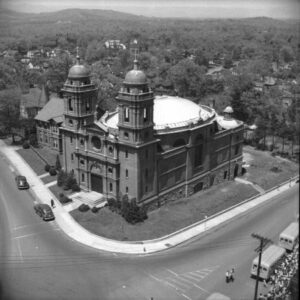
Asheville Architecture:
Ellington’s Contemporaries
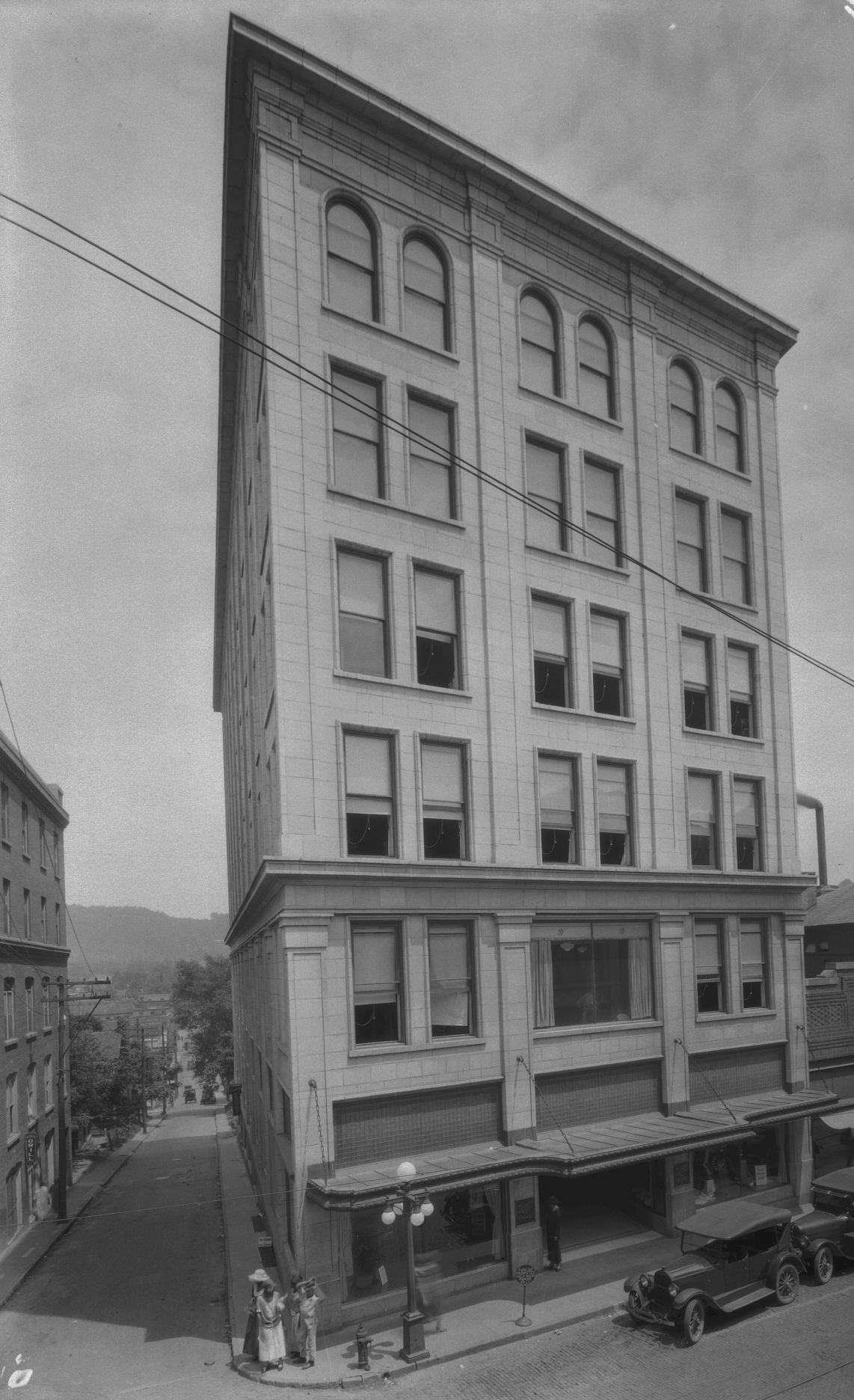
LOUGHRAN BUILDING, 1923
Soaring above Haywood Street at its intersection with Walnut Street is the Loughran Building – Richard Sharp Smith’s last and most forward-looking project. Built during Asheville’s building boom of the 1920s, it was for one year the city’s tallest building. It was eclipsed one year later by the thirteen-story Jackson Building
The steel frame, brick, and white glazed terra cotta building’s design was influenced by the commercial architecture proffered by a group of Chicago architects. The second story is capped by a main frieze and modest cornice creating a “base” for the rest of the building. Tall vertical pilasters quickly move the eye past the crisply cut paired windows to the crowning cornice. Built for Asheville business man Frank Loughran, it was first home to Denton’s, a Chicago-based department store chain. In 1936 the building was sold to J.C. Penney’s. During the 1960s Penney’s – following the other major retail stores which then lined Haywood Street – moved to a suburban mall. After years of vacancy it is now home to the Mobilia Furniture Store. Its upper floors have been reconfigured into condominiums.
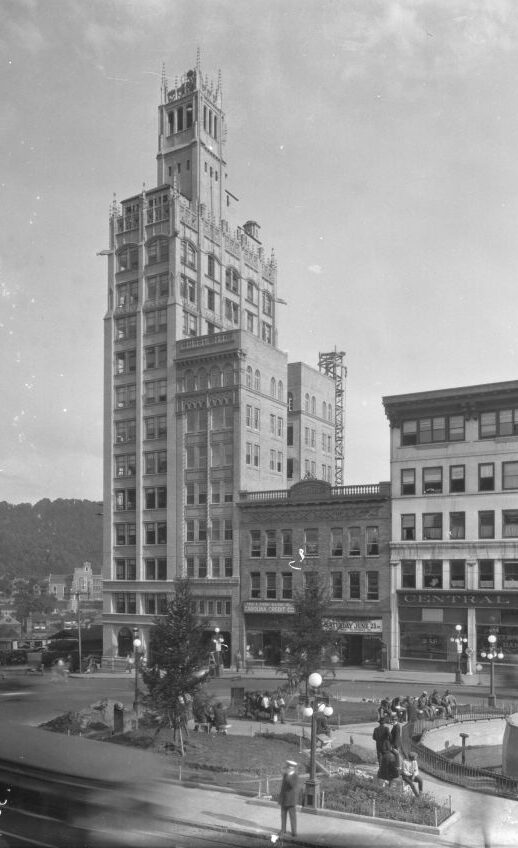
JACKSON BUILDING, 1924
When, in 1923, Asheville real estate developer Linwood B. Jackson commissioned Ronald Greene to build a structure which would advertise his business, he was given two instructions. It was to be the tallest building in western North Carolina. And, the architect was given free rein to design the top of the building, with no restrictions. The result is not only Asheville’s first skyscraper but a masterpiece of Neo-Gothic whimsy. Located at the corner of Patton Avenue and Market Street on Pack Square, the steel frame, brick and terra cotta 13 floor building sits on a small 27 x 60 square foot lot. Dragon grotesques protrude from the twelfth floor and the building is capped with a tower resembling a bell tower. At one time the tower featured a search light which illuminated the surrounding mountains.
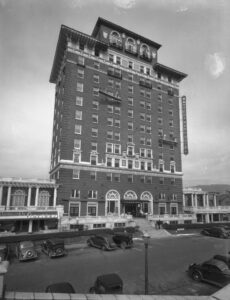
BATTERY PARK HOTEL, 1924
The Battery Park Hotel on Battle Square is a 14 story T-plan Neo-Georgian building built in 1924 of steel framing and brick, with touches of Neo-Classic elegance and Spanish Romanticism with pergolas, Ionic columns and tall arched windows. It is capped by a mission style roof. Originally the top two floors consisted of a multi-story penthouse, terrace, and roof garden. It was designed by William L. Stoddard – a New York architect who specialized in hotel architecture.
In 1922 Edwin Wiley Grove, pharmaceuticals tycoon and owner of Asheville’s Grove Park Inn, bought the Battery Park section of downtown. The existing hotel was razed and the hill on which it stood was leveled off – lowering the hill the equivalent of seven stories. The new hotel’s guest list was every bit as impressive as that of the original hotel, running the gamut from Sergei Rachmaninoff to Arthur Murray and Ty Cobb to Richard Nixon. Today Grove’s creation provides housing for senior citizens through the Federal Government’s Housing and Urban Development program.
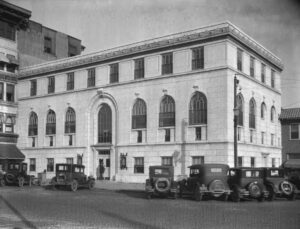
PACK MEMORIAL LIBRARY, 1926
Pack Memorial Library was built in 1926. The stately Second Renaissance Revival building was designed by Edward Lippincott Tilton. The four story building is faced with white Georgia marble and is ornamented with a low-relief classical cornice. Tilton, a New York architect, specialized in the design of libraries. Over an active career, which ran from 1890 – 1933, he designed almost 100 libraries. The building is now part of the Asheville Art Museum.
Lumber tycoon George Willis Pack moved from Cleveland, Ohio to Asheville in 1883 so that his ailing wife could benefit from the area’s climate. During his time in Asheville he became one of the city’s greatest philanthropists. In 1902 he left Asheville after his wife recovered. Pack died in 1906.
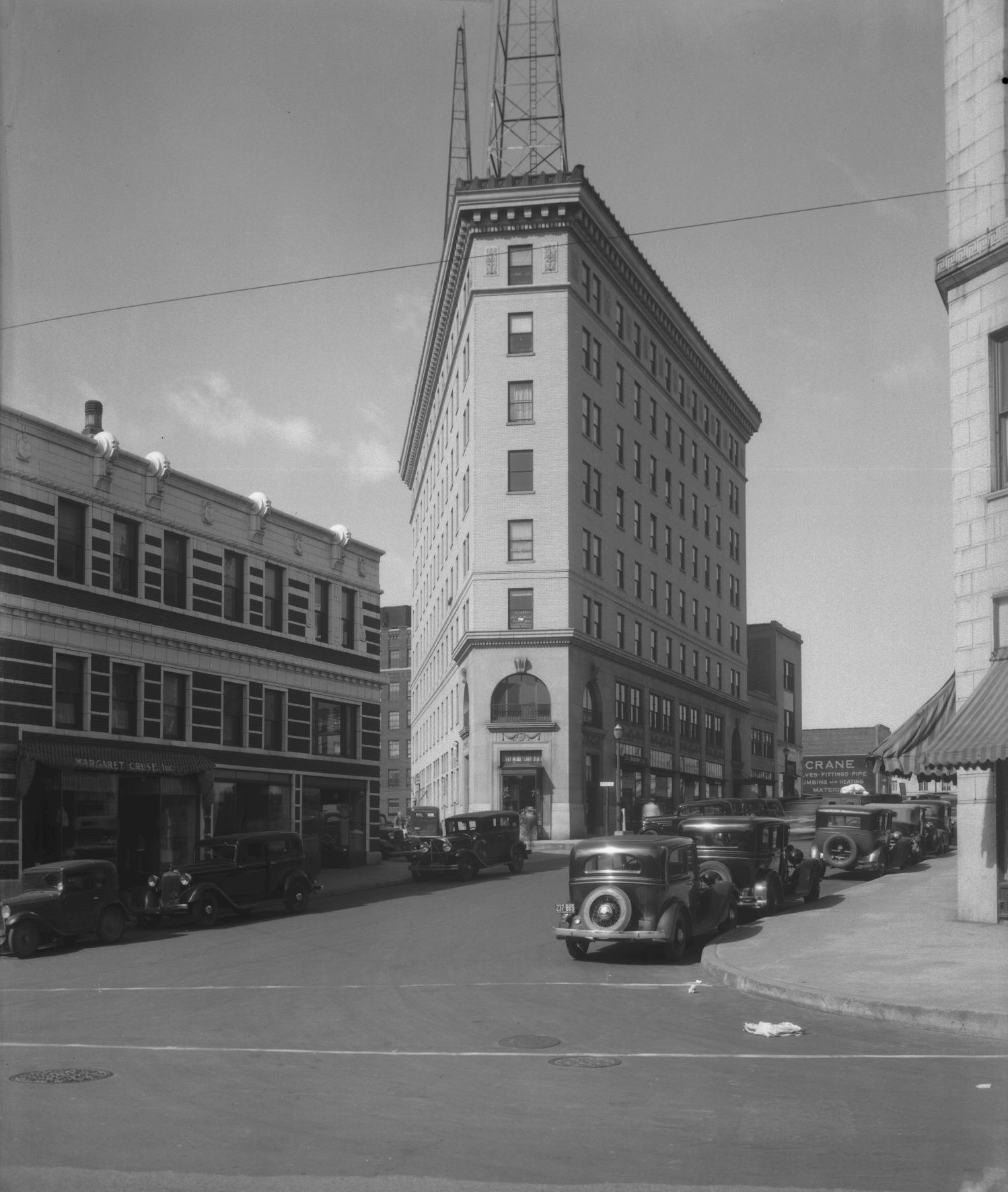
FLATIRON BUILDING, 1926
The imposing and classically detailed Flatiron Building at 10-20 Battery Park Avenue is considered the state’s best surviving example of the wedge-shaped urban form seen in so many larger cities. Its eight stories are constructed of tan brick. The first two floors are faced with limestone ashlar with low-relief ornament. The building is capped with a prominent cornice of limestone with molded copper parapet. In 1929 Asheville’s first radio station, WWNC, broadcast from the Flatiron Building. A 1,000-watt Western Electric transmitter was erected on its roof and the station advertised itself as the highest broadcasting station in the eastern United States at 2,496 feet.
The Flatiron Building was designed by Albert Carl Wirth. After working at a school of design in Toronto, he moved to Greensboro, North Carolina, where he became chief draftsman for Harry Barton, the city’s preeminent architect. After service in World War I he returned to Greensboro. He moved to Asheville in 1924.

KRESS BUILDING, 1927
The four-story Kress Building is one of downtown Asheville’s finest commercial buildings. Built in 1927 – at the height of Art Deco’s dominance of American architecture – the building features tan brick and cream glazed terra cotta with unusual flourishes that include a glazed blue and coral rosette border, a terra cotta frieze, and embellished cornice. An intricate parapet containing urns and the company name make it a remarkable example of the style.
Samuel H. Kress (1863-1955) was an American visionary. His chain of 5, 10, 25 cent stores brought many small commodities and conveniences to hometown American life. From lipsticks to padlocks, from teapots to rhinestone earrings, his stores were full of little treasures at affordable prices. As one of the country’s premier collectors of old master paintings, Kress distributed, through his own generosity or that of the Samuel H. Kress Foundation, works from his collection to art galleries around the country. Kress opened his first Asheville store in 1905. The new building of 1927 was designed by E. J. T. Hoffman. Today it contains two floors of retail space and three floors of condominiums.
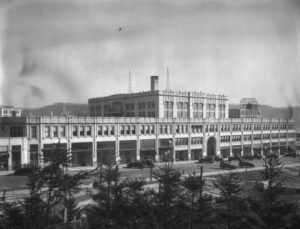
GROVE ARCADE, 1929
The Grove Arcade located at 37 Battery Park Avenue covers a city block and was built of reinforced concrete, stone and terra cotta tile. It is lavishly ornamented inside and outside with ivory glazed terra cotta in a Tudor Gothic Revival style. Inside open balconies run on both sides of each floor and sweeping spiral staircases connect the first and second floor. Ram’s heads guard the south entry while the north entryway is guarded by two winged lions. Built on a gradually decreasing slope the building is two stories high at the north end and three stories high at the south end.
The spectacular Grove Arcade is the second of Edwin Wiley Groves’ additions to the landscape of downtown Asheville. Today the second floor is devoted to office space while the third floor provides room for private residences. Architect Charles Newton Parker originally designed a central office skyscraper of seventeen stories. Construction of the arcade ceased upon Groves’ death in 1927. However, despite the economic downturn of 1929, construction resumed under Walter Taylor and Associates and was finished in 1929 – minus Parker’s central skyscraper, band shell and exclusive club.
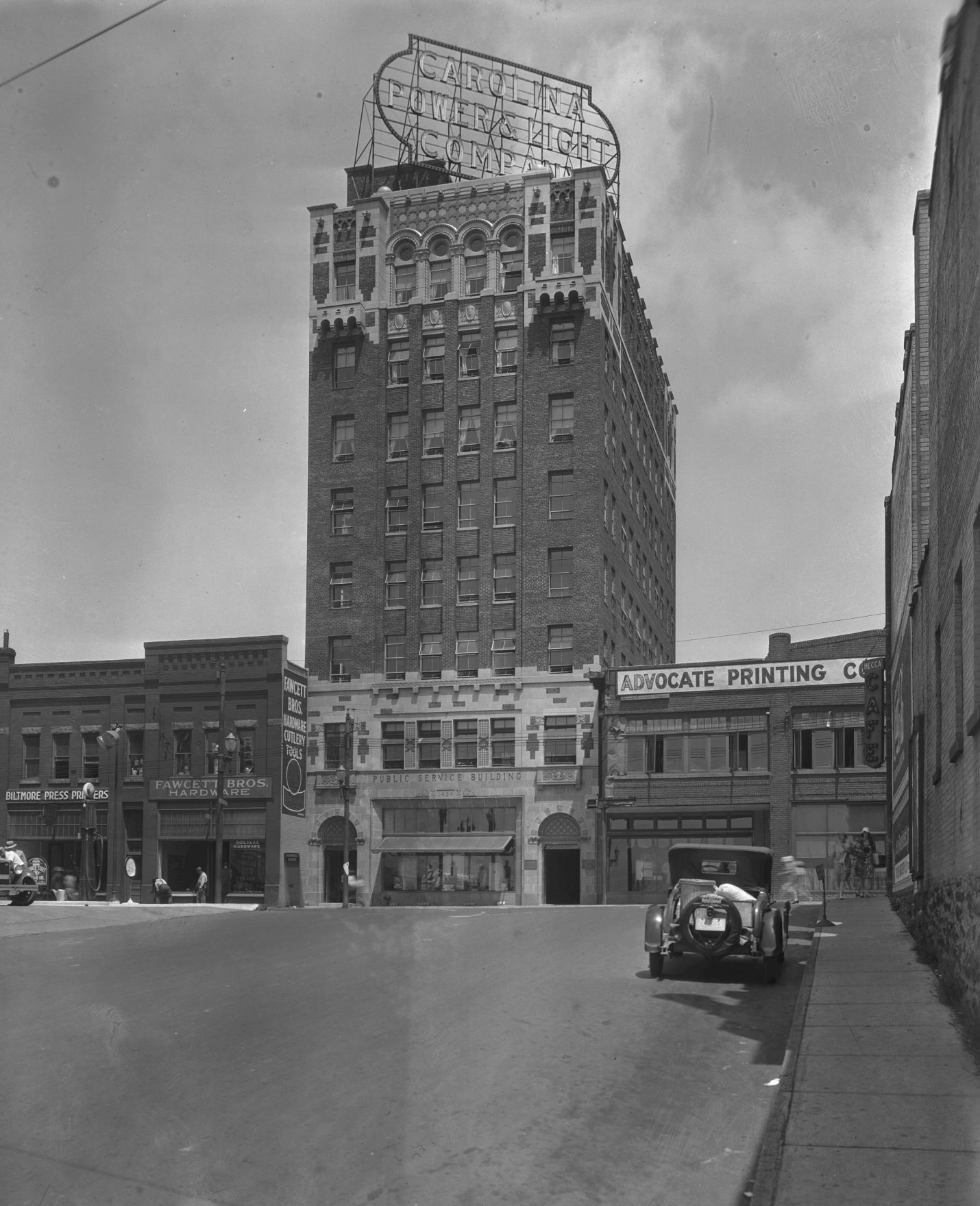
PUBLIC SERVICE BUILDING, 1929
The Public Service Building at 89-93 Patton Avenue is an eight story Spanish Romanesque skyscraper. Its steel framing is covered with bricks and it is highly ornamented with terra cotta. The first two floors on the front façade are embellished with whimsical details and mythological characters – including Leda-the-Swan and Neo-Spanish Romanesque architectural elements. The top stories explode with Spanish influences and ram grotesques which watch over the building from both front and back.
The Public Service Building was erected in 1929 and designed by the firm of Beacham & LeGrand of South Carolina. It was originally built for Carolina Power and Light and won an American Institute of Architect’s AIA Honor Award the year of its construction. 89 Patton Avenue is the only storefront that was refaced as originally planned to match the building. Despite their resemblance to gargoyles the ram’s heads at the top of the Public Service Building are, in fact, grotesques. True gargoyles function as part of a building’s down spout system.
ART DECO
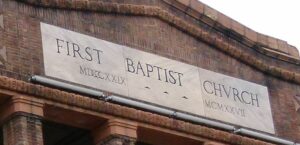
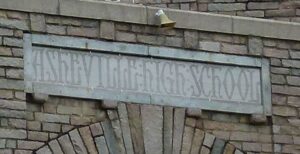
Art Deco details from Douglas Ellington’s architecture in Asheville. Courtesy of Michael Sartisky.
By the 1920s the world of American Architecture was marked by a plethora of overlapping styles ranging from Shingle, Queen Anne, Arts and Crafts, and Beaux Arts to numerous revival styles including Colonial Revival, Greek Revival, Egyptian Revival, Gothic Revival, Italianate, Renaissance Revival, Romanesque Revival, and Second Empire.
While Ellington’s Asheville buildings do incorporate elements of some of these styles, it is the introduction of several newer decorative styles which gave his buildings of the period their special flair.
The geometric style named Art Deco has been called the first truly 20th-century style and it was international in scope. It has been referred to as the “last total style.” During the 1920s and beyond elements of Art Deco decorated fast trains, tableware, radios, posters, theatrical and film sets, and fashion. The style lent itself to architecture. Cities across the United States and around the world are replete with Art Deco buildings from cinemas to office buildings, restaurants to hotels, and private residences to government offices.
Strangely enough, the term Art Deco was not coined until 1968 when British art historian Bevis Hillier published Art Deco of the 20s and 30s. Before then the style was loosely referred to as Art Moderne. Yet it was more than forty years earlier that the style made its first large scale public appearance in Paris at the 1925 Exposition Internationale des Arts Décoratifs et Industriels Modernes.
The Art Deco style – especially in architecture – moved from the formalized classical ornamentation of the past toward a sense of simplicity in line and shape, often incorporating an exuberant use of color. While Art Deco often evolved from Art Nouveau, the style was reflective of the art movements known as Futurism and Cubism and incorporated motifs from Greek, Egyptian, Mayan, Aztec, Native American, and Asian cultures.
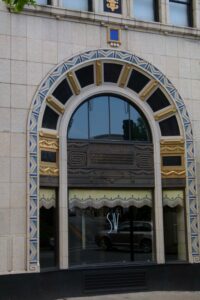
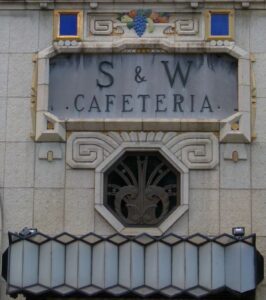
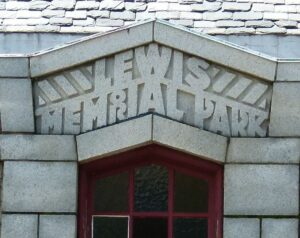
“While the art deco style in the United States certainly gained momentum from the 1925 Exposition Internationale des Arts Décoratifs et Industriels Modernes in Paris, its origins are equally indebted to the avant-garde architects and philosophies of design which had existed in this country since the late nineteenth century. These architects and philosophies included the Arts and Crafts Movement; the Prairie School, exemplified by Frank Lloyd Wright’s work; and architects such as Irving Gill on the West Coast and Robert D. Kohn in New York City, who promoted “modernity” as a moral mandate. Additionally, architects in the Americas were able to delve into vast resources of pre-Columbian and historic indigenous cultures for inspiration and exotic motifs, a feature of early 20th-century architecture that expressed a desire to break with past formulaic styles. Native American arts were geometric and highly stylized. Textiles produced by Navajo (Dinah), Hopi pottery, and other forms of Native American art became widely appreciated by artists and architects associated with the Arts and Crafts Movement, which also relied on geometric ornament. Frank Lloyd Wright and architects associated with the Prairie School, too, were inspired by indigenous cultures.
Each region of America has a unique history and environment that shaped the vision of architects and designers in the 1920s and 1930s. Motifs for art deco ornament were frequently inspired by regional flora and fauna, local history and traditional building styles.”
– American Art Deco Architecture and Regionalism
THE ASHEVILLE YEARS
(1925 – 1932)
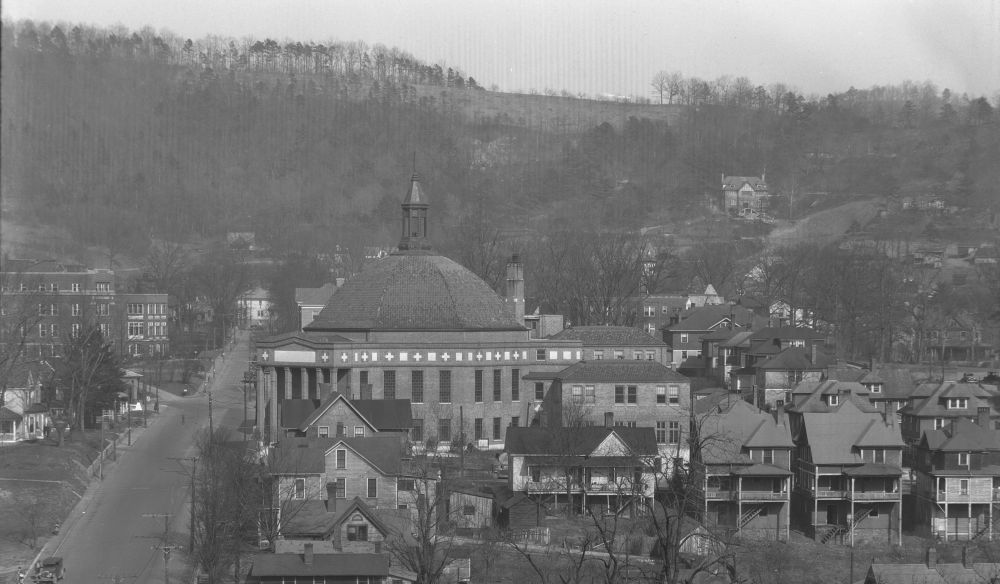
Douglas Ellington shot across the starry Asheville sky of the booming 1920s like a meteor. Within five short years he designed and completed four major structures that would change the nature of Asheville architecture and would define the city for years to come. He came to Asheville in 1925 armed with an impressive résumé which included study at the Ecole des Beaux Arts in Paris and five years as an instructor at Columbia University and at the Carnegie Institute in Pittsburgh … but with little practical experience. The structures that were erected during his Pittsburgh years – several restaurants, a Methodist Church, and a series of bridge abutments – gave little indication of the triumphs he would achieve in Asheville.
Then, with the nation reeling from the Great Depression of the 1930s, Ellington left Asheville. While he received numerous commissions in Maryland and in Charleston, South Carolina, the opportunity to build on the grand scale vanished. Nothing he designed after 1930 had the flair and dash of his Asheville buildings – a flair and dash that simply took your breath away.
FIRST BAPTIST CHURCH
(1925 – 1927)
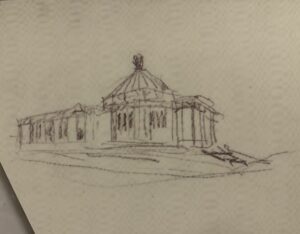
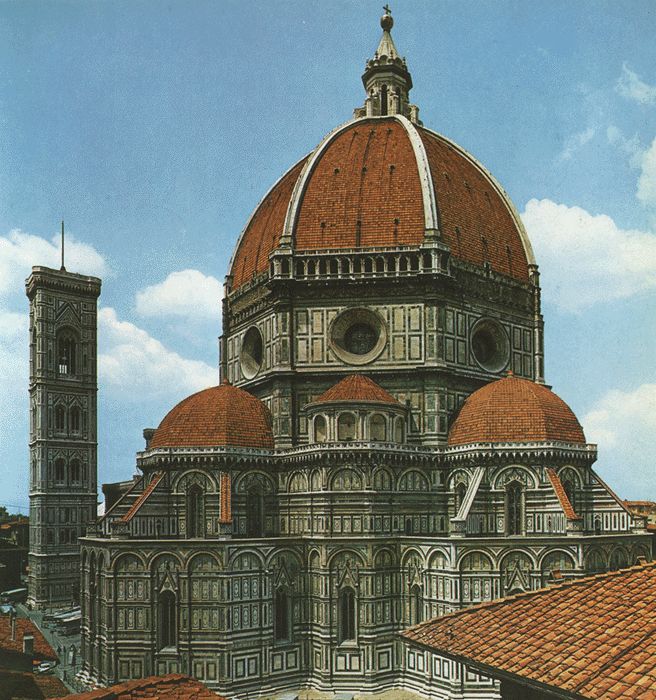
Usually identified as the main source of inspiration for the dome of Ellington’s First Baptist Church in Asheville, the Santa Maria del Fiore Church in Florence, Italy was designed by Filippo Brunelleschi in 1436.
Church records fail to disclose the genesis of Ellington’s commission for the First Baptist Church. While there is no record of communication between Ellington and church officials, strong evidence points to Kenneth Ellington’s involvement. The charming anecdote which has come down through oral tradition – that Ellington sat down with church officials at a local restaurant and, while waiting for food, drew his proposed design for the church on a napkin, seems to have little basis in fact.
However, a drawing that Ellington produced on the back of a photograph (now in the collection of the Asheville Art Museum) indicates that he was thinking in terms of a Renaissance inspired dome. Whatever the origin of Ellington’s relationship with the church, the structure he created for his first Asheville project is the most unusual Baptist Church in North Carolina.
Ellington’s first Baptist Church combines Renaissance, Beaux Arts, and Art Deco elements with religious symbolism. The colossal Beaux Arts inspired portico features six stylized columns with abbreviated capitals and white marble bases. The figure of the octagon – a Christian symbol of the beginning of life – is fundamental. It is the basis for the foundation of the dome and shape of the dome, and occurs as an ornamental figure in the three chestnut front doors, as well as repeated in the three octagonal lanterns which hang in the two-story portico.
The church is adorned with images of the Greek Cross which also generates additional decorative octagons. Later additions to the church include: a 1970 children’s Building, a 1980 Family Ministries Center, and a 2008 secondary entrance, maintain the original Ellington panache.
Most impressive in effect is the church’s dome. While the crowning cupola appears to have aged or rusted to the color verdigris and while the ageing process seems to be progressing down the sides of the dome it is, in fact, one of the most ingenious trompe l’oeil effects ever created on a major building. The surface of the dome is constructed of terra cotta tiles which gradually progress from the verdigris at the top to bright orange at the base. In effect, the dome was created “pre-aged.”
MERRIMON AVENUE FIRE STATION
(1927)
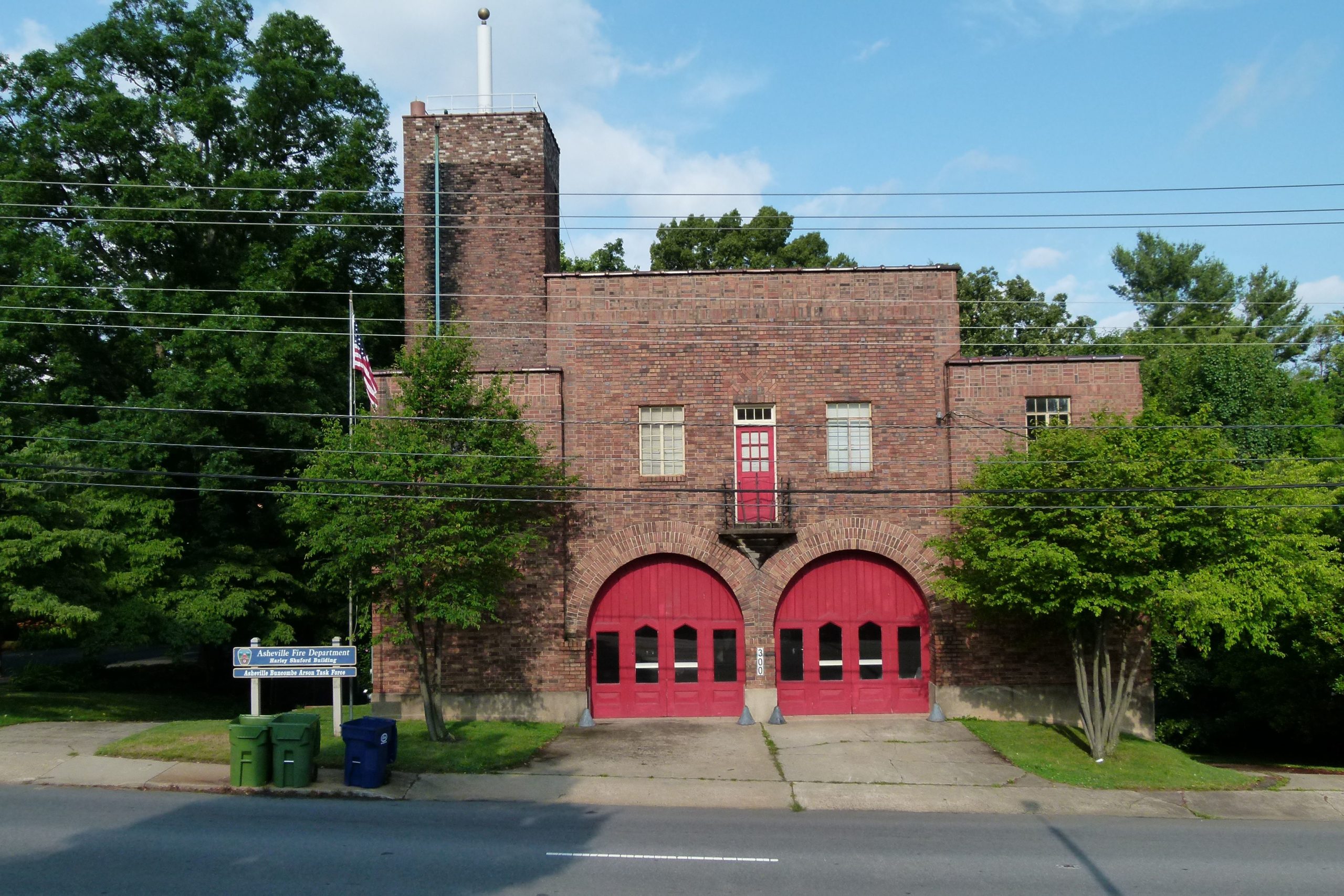
While Ellington worked on his large projects – by 1926 both the First Baptist Church and the Asheville City Building were under construction – he also undertook several more modest assignments. The first of these was the Merrimon Avenue Fire Station. Designed in 1926 and built in 1927, it lacks the more flamboyant features of his major buildings.
Nevertheless, within the functional design are some of the particulars (the whimsical wrought-iron balcony and the peaked windows of the fire house doors, which repeat the shape of the window alcove on the south wall) which distinguish his style and his attention to detail. Today the building houses offices of the Asheville Fire Department.
ASHEVILLE CITY BUILDING
(1926 – 1928)
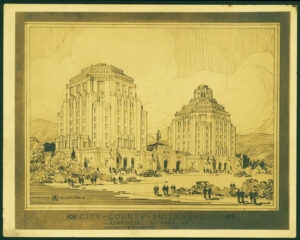
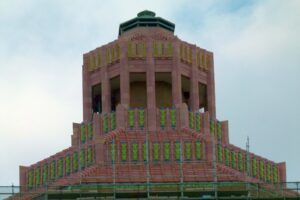
Douglas Ellington, championed by then Mayor John Cathey, was commissioned to design a civic center which would feature a City Building and a new County Courthouse. Ellington’s plan called for two buildings of matching architectural style. Asheville city officials appeared to be delighted with the design and the City Building was approved. However, the county commissioners stalled on the Buncombe County Courthouse building and eventually hired the architectural firm of Milburn and Heister of Washington, D.C., to produce a more traditional classic style County Courthouse building. A disappointed Ellington, when he first learned of the rejection of his plan for the County Courthouse from an article in the local press, responded with a scathing letter to the county commissioners.
Ellington wrote in part:
“I shall always believe that you three gentlemen, deep in your hearts, wanted to go ahead with the civic center as agreed of by you the City Commissioners on last July 6th on the basis of the architectural solution which I prepared at that time and on which your agreement with the City had its foundation. I believe this notwithstanding the fact that is some instances it has been proclaimed that you gentlemen found me stubborn and impossible to work with, notwithstanding the fact that you did not give me notification or a hearing before your full Board prior to making public announcement of your decision not to abide by the general civic center scheme, notwithstanding the fact that your final action was a very thorough repudiation of me and my work.”
Ellington combined influences from the surrounding mountain landscapes, Native American motifs, and Art Deco modernity. The reaction to the building by Asheville’s natives was somewhat mixed. Some found the pink and green tiled ziggurat inspired roof somewhat bizarre. Some said it looked like a nipple! Today it is regarded as an Art Deco period masterpiece, and serves as the symbol of the city of Asheville.
BILTMORE HOSPITAL EXTENSION
(1929 – 1930)
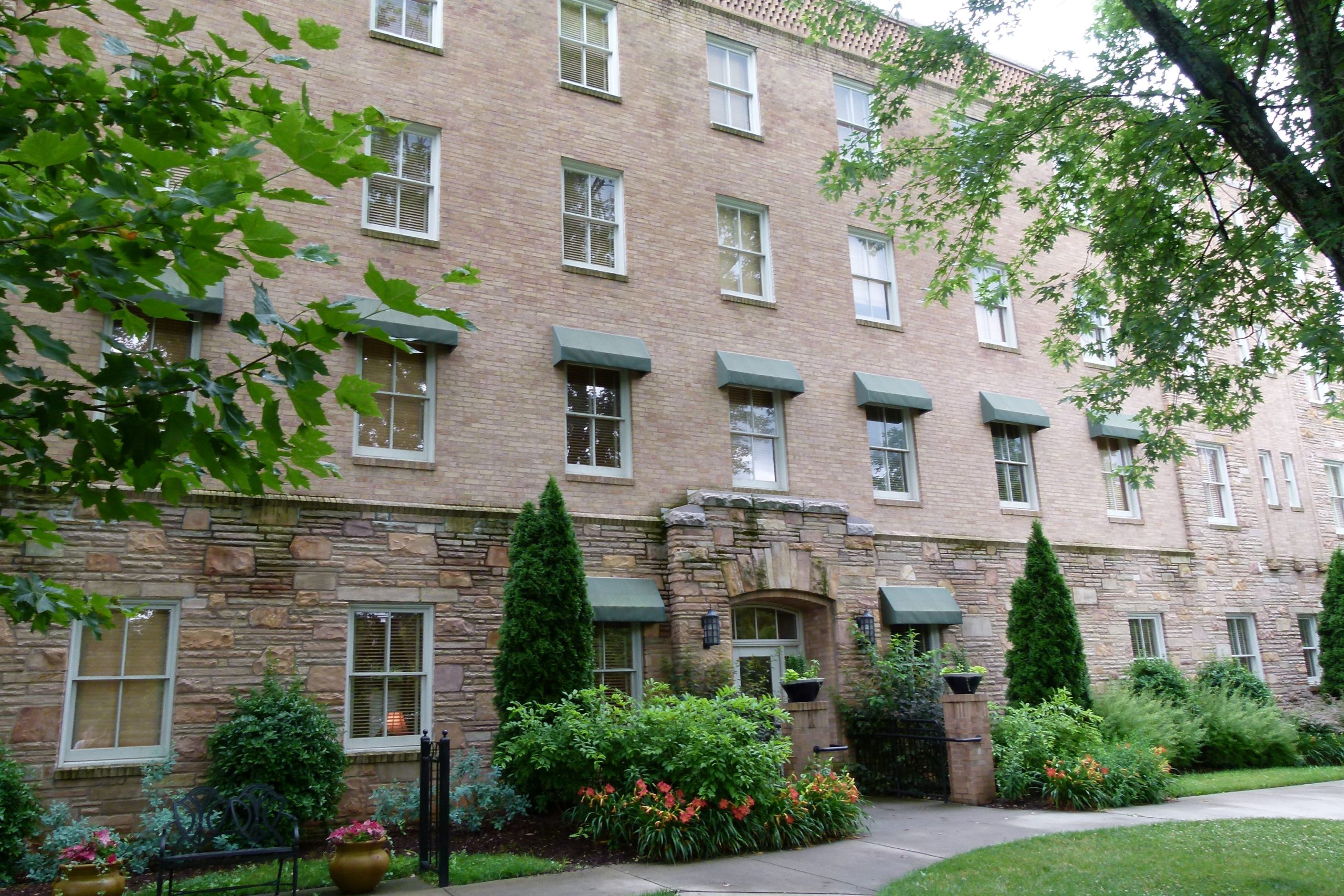
While Ellington was busy with the construction of the S & W Cafeteria and Asheville High School, he designed the Biltmore Hospital Extension located at 14 All Souls Crescent in Biltmore Village. It is a modern, functional building containing 65 rooms. It was originally known as the Battle Wing. Dr. Westray Battle had been physician to George and Edith Vanderbilt and a frequent guest at their elaborate formal dinners.
The building was eventually home to the Imperial Life Insurance Company. Today it is home to a boutique hotel.
ASHEVILLE HIGH SCHOOL
(1927 – 1929)
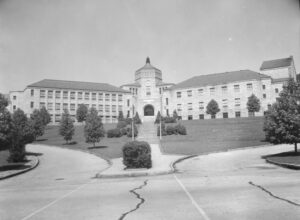
By the time Douglas Ellington received the commission to design a new high school for Asheville he had been working in the city for just over two years. With the First Baptist Church project almost complete and with the futuristic City Building well into construction, Ellington had established himself as the architect who most completely espoused the city’s philosophy of “program of progress.” Seven architects were invited to submit designs. Ellington’s design was chosen unanimously.
Ellington’s first challenge was the site – 50 acres of rolling hills. In an article he wrote for “The Architectural Record” he described his solution to the problem.
“The initial step in solving the architectural problem was the preparation of a plaster model of the general property and approaches, followed by plaster blocks scaled to parallel the floor and are area requirements of the high school program . . . These plaster blocks, in mobile units, were then studied for assemblage, the architectural idea being to combine these sub-units in such a way as to secure symmetry and coordination or requirements and location without disturbing the natural slopes no more than absolutely necessary.”
Anchored by a hexagonal central tower are three wings forming a Y-pattern. The building feels like a natural outgrowth above the six-tiered terrace.
Note: The six tiers are reflected in the six tiers of the pagoda inspired “cap” on the tower. The rough faced granite, which covers most of the building, is from the “Balfour Pink” quarries located near Salisbury, North Carolina.
LEWIS MEMORIAL PARK OFFICE
(1927)
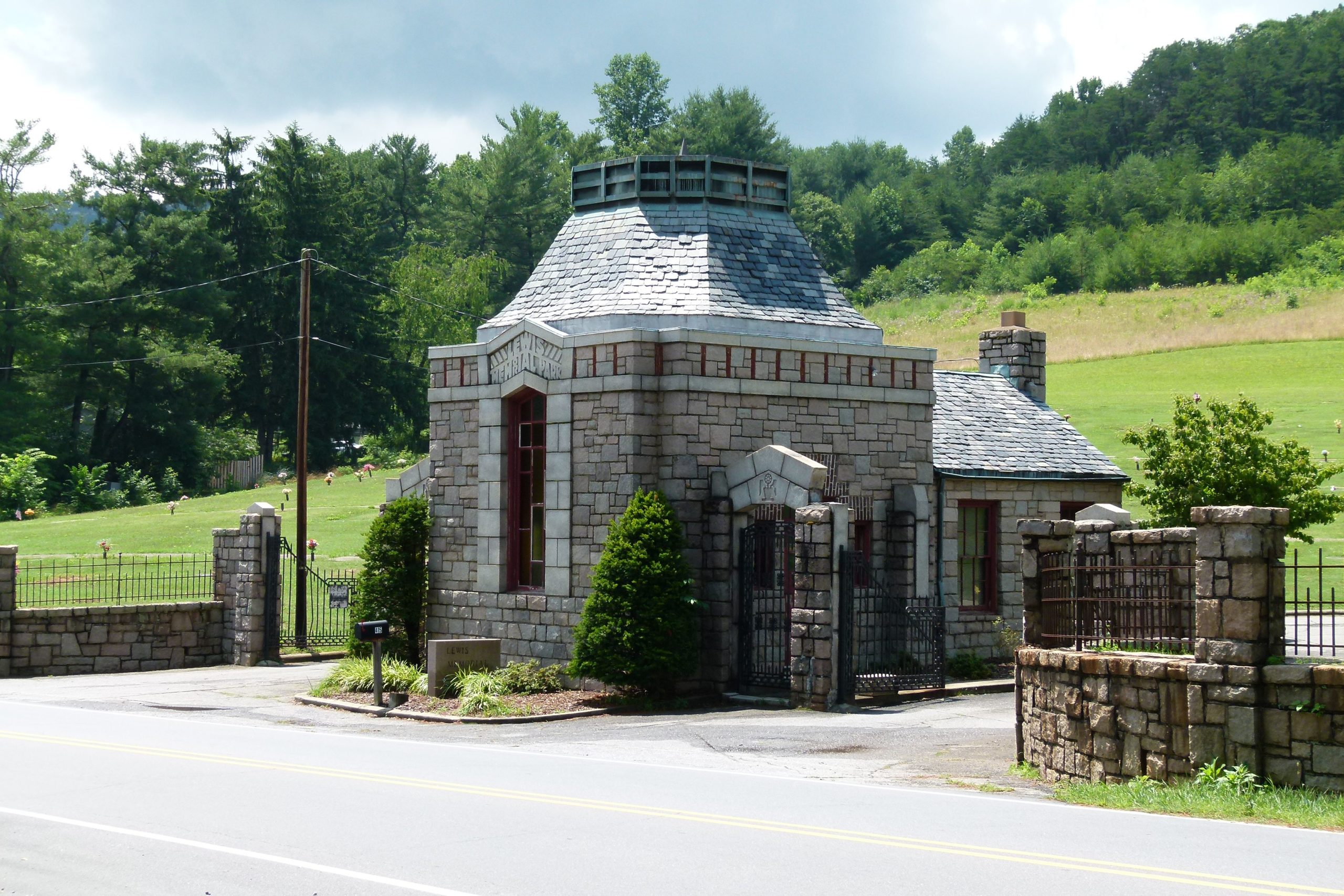
Designed in 1927 at the time when the First Baptist Church was nearing completion, when the Asheville City Building and the Merrimon Fire Station were under construction, and when Ellington was designing Asheville High School, the commission to design an office for a cemetery at 415 Beaverdam Road in Asheville may have seemed anticlimactic. Nevertheless, Ellington’s design for the office exhibits the same dedication to detail that is indicative of his larger projects. Once again the octagon in the roof – a Christian symbol of life and rebirth – is prominent.
S & W CAFETERIA
(1929)
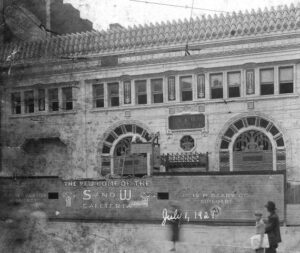
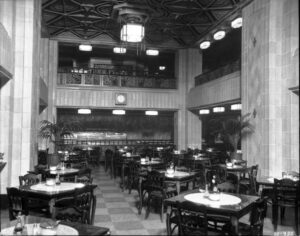
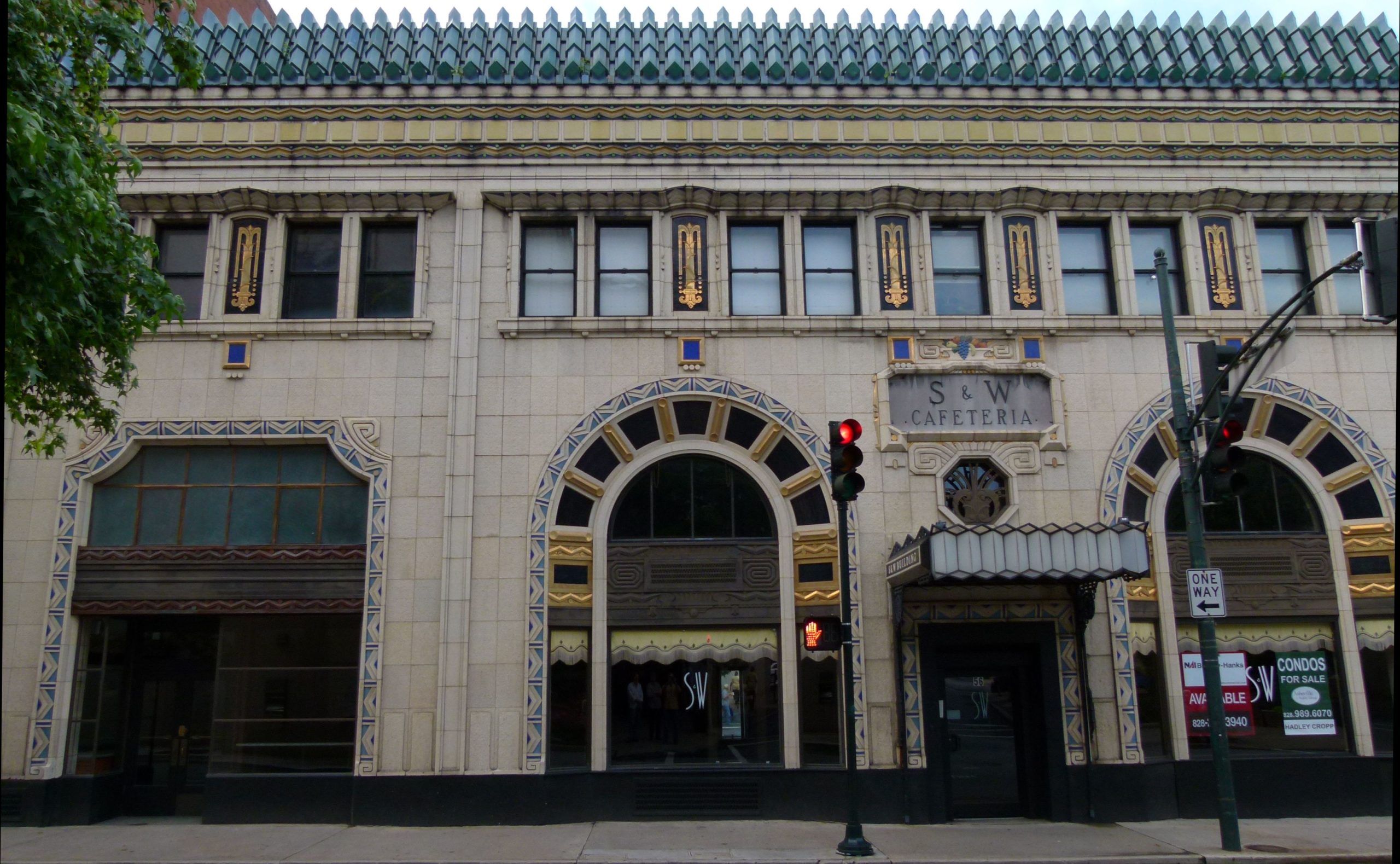
The S & W Cafeteria chain was organized in 1920 by Frank O. Sherrill and Fred R. Webber. The two had served together as mess sergeants during World War I. The chain, specializing in low-cost, southern style cooking eventually spread across the South. The original cafeterias were usually located in busy downtown areas, often located near theater and shopping districts.
Asheville’s original S & W Cafeteria opened in 1922 and was located on the ground floor of the Grand Opera Building at 41-43 Patton Avenue. With the city’s building boom in full swing and with the cafeteria’s ever expanding cliental, Douglas Ellington was commissioned to design the new S & W Cafeteria at 56 Patton Avenue near present-day Pritchard Park.
It was Ellington’s last major commission in Asheville. Still under construction when the stock market crashed in 1929, the owners elected to forge ahead and finish the building. It operated at that location until 1947, when it relocated to the Asheville Mall.
A jewel box of a building, Ellington’s S & W Cafeteria is considered by many to be North Carolina’s finest example of Art Deco architecture. With poly-chrome cream, blue, green, black, and gilt terracotta and including stylized inserts of food and Native American motifs, he concocted an effusive fantasy of the style’s whimsical side.
Note: the main entrance is not located at the center of the building. Rather, Ellington designed the entry was to face directly on to Haywood Street.
A number of attempts have been made to reopen the S & W Cafeteria.
In 2007, Steve Moberg purchased, renovated, and reopened it as the Steak & Wine Restaurant. Despite outcry from local preservationists, six condos were constructed within the original third floor and four condos were added to the roof as part of the renovation. The added condos on the roof are so recessed from the front of the building and so unobtrusive in design that they have little impact on the architectural integrity of Ellington’s original design.
In 2023, the old cafeteria is home to a food hall and taproom.
As was the case with many talented artists, Ellington did not think in terms of working within a particular style. Beethoven did not think of himself as a member of the “Viennese Classical School.” Bach did not realize that his music would be labeled “Baroque” years after his death. John Milton borrowed from several traditions to make his later works and Monet didn’t like being labeled an “Impressionist.”
Ellington’s Asheville buildings are a synthesis of styles. Elements of Art Deco can certainly be found in all of his buildings of the period. However, there are also traces of Renaissance styles, as well as Oriental, Native American, and Beaux Arts influences. And, perhaps most importantly, there are features which are pure Ellington. These arose from his education, his life of feeling, and his designing and artistic experiences. But there is something else. It is something that is far more difficult (perhaps impossible) to quantify. It is the crossing of “wires in the brain” and the connections of feelings that enable some to see what is invisible to most – it is the thing we call genius.
DOUGLAS ELLINGTON HOUSE
(1926 – 1930)
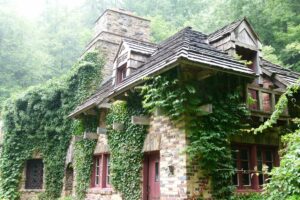
Ellington’s first residence in Asheville was number 10 within the Woodfin Apartments. By 1928 he was living at 4 Evergreen Lane in the Grove Park district. However, it is the home, pictured here, that he built for himself and his brother’s family at 583 Chunns Cove Road that is always referred to as the Douglas Ellington House. He worked on the house from 1926 to 1930 using materials left over from his other Asheville construction sites.
THE POST ASHEVILLE YEARS
(1932 – 1955)
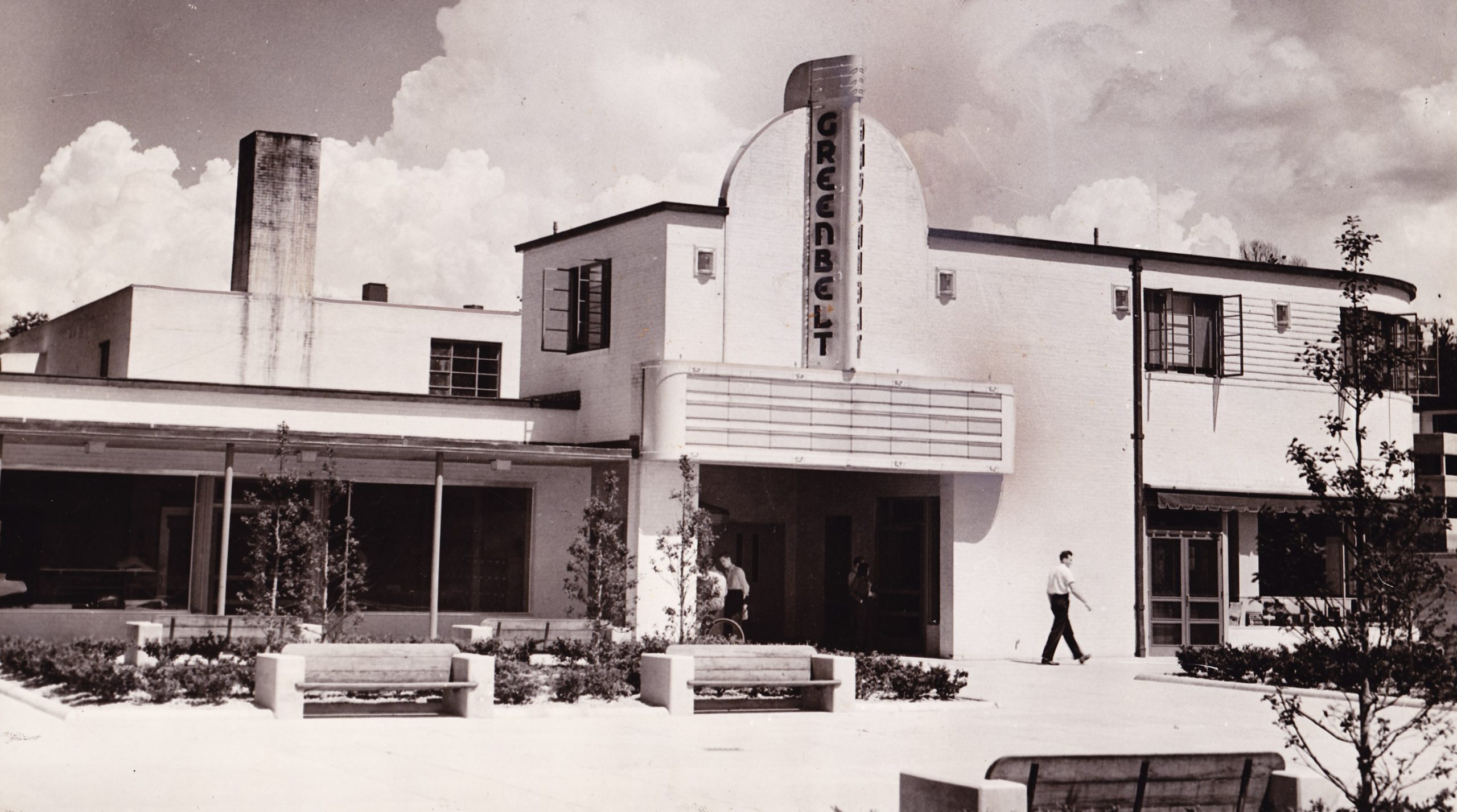
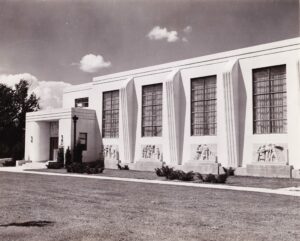
During Douglas Ellington’s post Asheville years he produced three distinct bodies of work. While summering in Asheville between 1932 and 1955, he designed a number of private residences for local citizens. Most are of modest proportion but all exhibit the great care that he applied to his major Asheville buildings. Each design resulted from extensive consultation with his clients and with a careful study regarding how the home would “sit in the land.” Most of these residences still stand and many are currently occupied.
During the mid-1930s Ellington was hired as lead architect for Greenbelt, Maryland. Located just northeast of Washington D.C., it was one of three communities that were funded by the federal government and that were literally planned and built from the ground up. Ellington led a team of architects and builders who created a community with schools, entertainment centers, apartments, retail establishments, and community health facilities. Because it was a project of special interest to President Roosevelt and because tax payer dollars were involved, detailed records, both written and photographic, were preserved. It is within the theater and the elementary school which Ellington designed for Greenbelt that we see his use of the elements of the Art Deco style in their purest form as well of his adaption of features of European Modernists movements.
The remainder of Ellington’s work centered in and around Charleston, South Carolina. By 1939, he had established a permanent residence there. He directed the renovation of the city’s Dock Street Theater, designed a number of buildings for the Charleston Naval Station, and he designed residences for the Ashley Homes Project, a community of temporary housing for families during World War II. And, using Charleston as a base he designed several churches in South Carolina and Georgia and two fraternity houses on the Chapel Hill campus of The University of North Carolina.
Douglas Ellington never really retired. Between projects he produced watercolors, crafted jewelry, and built unique chess sets. His last project, Advent Lutheran Church of Charleston, was completed in September of 1959. He died of cancer on August 27, 1960 at his Chunns Cove residence and is buried on his Asheville property.
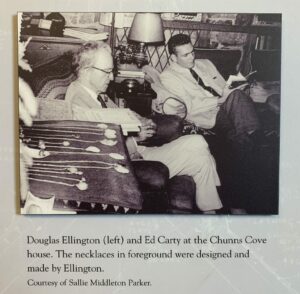
Curator:
John Turk
Sponsors:
Esse Quam Videre Foundation
First Citizens Bank
Donna and Robert Kelly
Robin Ellen Meyers
Special Thanks:
Advent Lutheran Church, Charleston
Melinda Jones, Pastor
Asheville Historic Resources Commission
Stacy Merten
Ralph Burns
First Baptist Church
David Blackman, Coordinating Pastor
Richard and Janet Graham
Greenbelt Museum
Megan Searing Young, Director
J. Richard Gruber
Sallie Middleton Parker
Michael Sartisky
Digitized By:
Anne Chesky Smith

